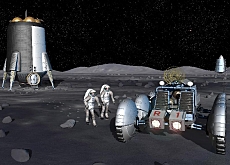Space specialist dreams of new life forms

Swiss astronaut Claude Nicollier is the subject of a documentary, "For the love of the sky", that chronicles far more than his life as a pilot and space specialist.
Nicollier, the only non-American to have been given mission specialist status by Nasa, tells swissinfo how the film highlights his passion for science fiction and his belief that life can be found all over the universe.
The film, shot by his niece Maria Nicollier, aims to show not only the adventures of the 62-year-old astronaut, but also the man behind the fire, smoke and thunder of a space shuttle launch.
swissinfo: In the documentary, you quote “2001: A Space Odyssey,” “Star Wars” and “E.T. the Extra-Terrestrial”. Does an astronaut need to be a fan of science fiction movies?
Claude Nicollier: Of course. And you need to read comic books too. Tintin in “Destination Moon” and “Explorers on the Moon” [written in 1953 and 1954] was an inspiration for me. Films helped me because they let you dream. My job might be a technical adventure, but it’s also a dream come true. When you are between missions, science fiction films or books help nourish that dream.
My passion is also fuelled by all the space exploration missions going on and everything that is being done to improve our understanding of the universe. Robot missions to Mars are gripping stuff for astronauts, because we all think that one day humans will go there too.
swissinfo: Don’t you regret never being able to go there yourself?
C.N.: Not really. I always knew I would never fly to Mars because it will be very difficult and it will only take place in a few decades. The fact that I have been able to contribute in a small way to manned spaceflight is satisfying enough.
swissinfo: You believe that mankind will travel well beyond Mars one day, even if you know it is not that simple…
C.N.: I always avoid saying something is impossible. Flying in aircraft that approach the speed of sound wasn’t even imaginable 150 years ago.
Physics will be a hindrance [travelling through space.] You can’t go faster than the speed of light for example. Finding life forms will also be difficult, as they will be spread out thinly through the universe. That means we will have to travel huge distances equivalent to tens, hundreds or even thousands of light years. But that doesn’t mean it can’t be done.
swissinfo: You believe that life can be found throughout the universe. Is that something you share with other astronauts?
C.N.: It’s very common. There are different degrees of belief, but I don’t know of any astronaut who has said that only Earth harbours life.
Are there more advanced civilisations than ours? Perhaps. But we think the most widespread forms of life would probably be quite simple and primitive because that is the likely way they would develop somewhere in space given the right conditions.
And perhaps there are some cases, maybe even quite a few, where life has evolved as it has done on Earth. And it isn’t over: who knows who our descendants or successors will be in a million years? Their capacities will certainly be vastly superior to ours.
swissinfo: In his 1985 novel “Contact”, US astrobiologist Carl Sagan imagined mankind joining forces on a project to send astronauts into deepest space. We seem to be a long way off that.
C.N.: Some steps have been taken in the right direction. The International Space Station is a modest example of what can be done, with the United States, Russia, 11 members of the European Space Agency, Canada and Japan all taking part in peaceful exploration of space. It was launched not long after the end of the Cold War, marking a clear change in geopolitics and the end of the East-West space race.
The new element in space travel is China. The recently announced plans to send men back to the Moon before 2020 and then on to Mars in 2030 were probably inspired by China’s capacity to send people into space.
swissinfo-interview: Marc-André Miserez
Born in 1944, Nicollier received a Masters in astrophysics from Geneva University in 1975.
He began his career as a pilot in the Swiss Air force in 1966, reaching test pilot status in 1988. He also worked for the former national carrier, Swissair, in the 1970s.
He joined the European Space Agency in 1976, before being chosen as one of its first astronauts in 1978. He was detached to the American space programme in 1980, joining Nasa’s team of future space shuttle specialists.
He later took part in four shuttle flights, logging more than 1,000 hours in space. He flew as a mission specialist in 1992, 1993, 1996 and 1999.
During his last mission, he took part in repairing the Hubble space telescope, spending over eight hours walking in space.

In compliance with the JTI standards
More: SWI swissinfo.ch certified by the Journalism Trust Initiative













You can find an overview of ongoing debates with our journalists here . Please join us!
If you want to start a conversation about a topic raised in this article or want to report factual errors, email us at english@swissinfo.ch.